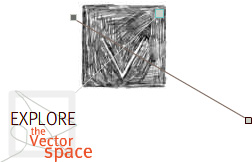Unmarked Planes and Hidden Geographies
Design by Craig Dietrich & Raegan Kelly
Editor's Introduction
In its year-end roundup for 2006, the New York Times declared "sousveillance" to be one of the key "ideas" of the year. Never mind that the list also includes "yodeling" "tushology" and "digital maoism," when the NYT shows up with a six-pack under its arm, the party is probably nearly over anyway. Trevor Paglen didn't invent the idea of reversing the gaze of the cultural panopticon, but he has been doing it with extraordinary virtuosity for nearly ten years. Legend has it that Paglen, who has been called the Fox Mulder of cultural geography, was personally instrumental in provoking the military to extend the perimeter around Area 51 by several miles in an attempt to thwart one of his counter-surveillance efforts, which he dubs "limit telephotography." Basically, Paglen leads tours around the edges of the military industrial complex, and true to his training as a geographer, maps the contours and the surfaces that conceal as much as they give away. Even black-world operations, the government's double-secret programs that take place largely in remote deserts and mountains, involve people and objects such as planes. And just as people and objects obey certain basic laws of physics (such as having mass and taking up space), they can be tracked using tools that are variously high and low tech ”" from high-power telephoto lenses to FAA flight-tracking data. Unmarked Planes and Hidden Geographies has it all. Fuzzy counter-surveillance photos taken from miles away sit side-by-side with crisply rendered map tracking data that shows the routes taken by planes with blocked tail numbers and no official destinations.
Paglen's work deftly limns the boundaries between art and scholarship while also suggesting a provocative conjunction of politics and tourism. His unassuming prose requires visitors to read between the lines in order to generate their own interpretations and conclusions. Even if the truth is out there, Paglen's work argues implicitly, finding answers is not an easy task. As access to unalloyed truth seems increasingly to occupy an elusive position on an infinitely receding horizon, Paglen's rare type of work becomes ever more important. A responsible citizenry may no longer rely (if indeed it ever could) on official pronouncements from corporate and governmental press offices. Instead, those who wish to educate themselves about the world must function as detectives or journalists, following threads and triangulating sources. Paglen's work is exemplary for its insistent look at some of the things we may least want to admit about our government. And his method is ultimately pedagogical, proferring more questions than answers, along with hints about how to uncover the truth for ourselves, if only we have the nerve to do so.



